Sourcing Fabrics: A Key Aspect of Garment Sourcing
The process of garment sourcing is complex and diverse in the fashion world. It carefully selects and acquires appropriate textiles for garment production. This includes finding the perfect fabric type, analyzing suppliers, negotiating costs, assuring quality standards, and effectively managing the supply chain.
This blog delves into the vital role of garment sourcing, challenges, and innovative approaches for garment sourcing influencing the fashion industry.
What is Garment Sourcing?
Garment sourcing is the meticulous process of acquiring materials and resources for clothing production. It includes the selection of suppliers, material procurement, and supply chain management.
Garment sourcing ensures on-time, cost-effective, and high-quality apparel production. It is crucial in the fashion industry to connect creativity and shipping to bring novel clothes to market.
Significance of Garment Sourcing in the Fashion Industry
Let’s explore the significance of garment sourcing to help you understand the fashion industry better.
1. Assured Product Quality
Proper material and supplier selection is essential to ensure the final product’s quality. The fabric selection directly impacts the overall quality of the garment, the manufacturer’s skill, and the level of attention to detail at every manufacturing stage.
2. Minimize Production Expenses
The fashion industry can minimize its production expenses by locating manufacturing facilities and suppliers that offer competitive pricing. This raises profit margins and permits competitive pricing in the marketplace. Achieving a delicate balance between cost and quality requires innovative clothing sourcing.
3. Quick Market Approaches
A new competitive advantage in this fashion industry is the capacity to bring new designs to market quickly. Sourcing of garments is essential to maintaining an effective and adaptable supply chain. The fashion industry shortens lead times and reaches customers more rapidly by optimizing the entire process, from sourcing materials to manufacturing and delivery.
4. Various Design Options
Sourcing examines the wide variety of textiles and components used in garment manufacturing. Fashion designers can experiment with various design options, from exquisite silks to sustainable organic cotton.
5. Competitive Market
It is a challenge to stay competitive in the fashion industry. Brands can differentiate themselves in a diverse market by focusing on successful garment sourcing. High-quality materials and ethical methods can distinguish a brand and attract customers who appreciate these values.
Recognizing the importance of garment sourcing and exploring its power distinguishes the thriving fashion industry from the competition.
6 Common Challenges in Garment Sourcing
When it comes to procuring materials, fashion industries face many recurring challenges.
1. Disruption
Event-related disruption to the supply chain, such as natural disasters, political upheaval, or international crises, can cause delays in the delivery and production of fabrics.
2. Cost Variability
Fabric prices can fluctuate, influencing production budgets. Currency exchange rates and market developments can affect cost fluctuations.
3. Quality Control
It is vital to ensure constant fabric quality. Material quality variations impact the final product’s integrity and customer satisfaction.
4. Sustainability and Ethical Sourcing
Finding suppliers who have these principles is a challenge when meeting customer needs for sustainability and ethically sourced fabrics.
5. Lead Time
Managing fabric order lead times is challenging as delays impede timely production and product launches.
6. Strong Connections
Building strong connections with fabric suppliers is vital for securing reputable sources for your garment production. These relationships enhance the potential for quality and consistency in the fashion industry.
Overcoming these obstacles necessitates careful preparation, agility, and a dedication to quality and ethical sourcing techniques.
4 Critical Innovative Development in Fabric Sourcing
Explore the significant developments changing how fabric is sourced and enabling brands to enhance their performance.
1. Digital Platform and AI Integration
Supplier selections are transforming through AI and digital platforms. Algorithms analyze large databases to find the best fabric suppliers for the fashion business, which improves accuracy and saves time.
2. Sturdiness Tracking Using Blockchain
Using blockchain technology tracking the provenance and sustainability of textiles. This openness ensures ethically supplied resources to consumers and helps brands make eco-consciousness decisions.
3. Virtual Sampling and 3D Printing
The requirement for actual fabric samples is decreasing owing to 3D printing and advanced virtual sampling techniques. This promotes environmental stewardship by speeding up the design process and reducing waste.
4. Digital Platform for Supplier Collaboration
The fashion industry can work more effectively with suppliers using digital platforms. Obtaining fabric can run more smoothly by streamlining quality control, order tracking, and communication.
Also Read : Sourcing Fabrics: A Guide to Choosing the Right Materials for Your Apparel Line
Understanding Garment Sourcing: Elevate Your Fabric Sourcing With Saraogi Super Sales
The procurement of fabric plays a significant function that impacts the fundamental structure of the finished product. The thoughtful selection of materials influences fashion’s sustainability and design potential in addition to quality and cost.
Effective fabric sourcing allows the fashion industry to satisfy changing customer needs and embrace a more sustainable future while striking a delicate balance between innovation and efficiency.
Embrace your fashion supply chain with effective fabric sourcing. Contact Saraogi Super
Sales to start optimizing your garment sourcing process today.
Frequently Asked Questions:
What is fabric sourcing in garment industry?
What are the factors to consider when sourcing for fabric?
What are the stages of fabric?
What types of factors affect sourcing in textile exports?
What are the main properties of fabric?
Specializing in sourcing and exporting
a wide range of garments and apparel







